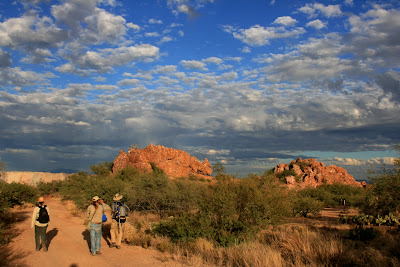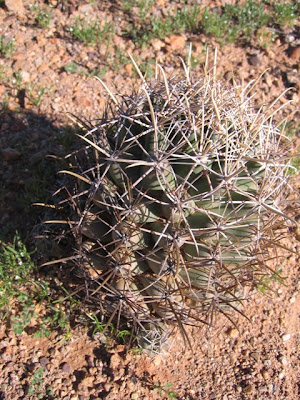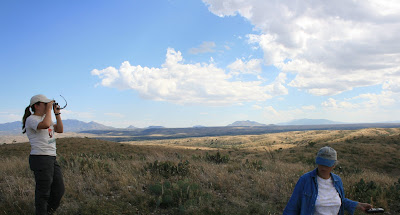
On the right is an energy bar made locally in Tucson. On the left is a leading-brand energy bar from anywhere else....
Label:

 This expedition, led by Patrick Dockens of EcoPlan Associates, traveled beyond the mine tailings of Green Valley and skirted the variegated edge of the beautiful Sonoran Desert to map the homeland of the rare & Endangered Pima Pineapple Cactus (PPAC). The PPAC is named for its shape, not its taste, and is primarily threatened by the voracious appetite of development & accompanying habitat destruction.
This expedition, led by Patrick Dockens of EcoPlan Associates, traveled beyond the mine tailings of Green Valley and skirted the variegated edge of the beautiful Sonoran Desert to map the homeland of the rare & Endangered Pima Pineapple Cactus (PPAC). The PPAC is named for its shape, not its taste, and is primarily threatened by the voracious appetite of development & accompanying habitat destruction. This quite large mother is shown carrying a single "pup" (at bottom of photo), a vegetatively propagating bud. The really cool thing about these surveys is that they provide an excuse to thrash around in the prickly heart of the Sonoran desert. Unless science mandates straight-line transects for statistical rigor, few would dare to brave the physical rigors of the desert for days and weeks on end. This labor bore the fruit of knowledge: we located several isolated populations of the Pineapple, and since we had also observed many places without populations of the cactus we began to form an idea of the microclimate and plant associations that the Pima Pineapple Cactus favors. Although it is only a hunch or an intuition, I believe that the members of this field crew are probably now better able to find this cactus than are any other people on Earth.
This quite large mother is shown carrying a single "pup" (at bottom of photo), a vegetatively propagating bud. The really cool thing about these surveys is that they provide an excuse to thrash around in the prickly heart of the Sonoran desert. Unless science mandates straight-line transects for statistical rigor, few would dare to brave the physical rigors of the desert for days and weeks on end. This labor bore the fruit of knowledge: we located several isolated populations of the Pineapple, and since we had also observed many places without populations of the cactus we began to form an idea of the microclimate and plant associations that the Pima Pineapple Cactus favors. Although it is only a hunch or an intuition, I believe that the members of this field crew are probably now better able to find this cactus than are any other people on Earth. 
 Source: Vplants.org
Source: Vplants.org